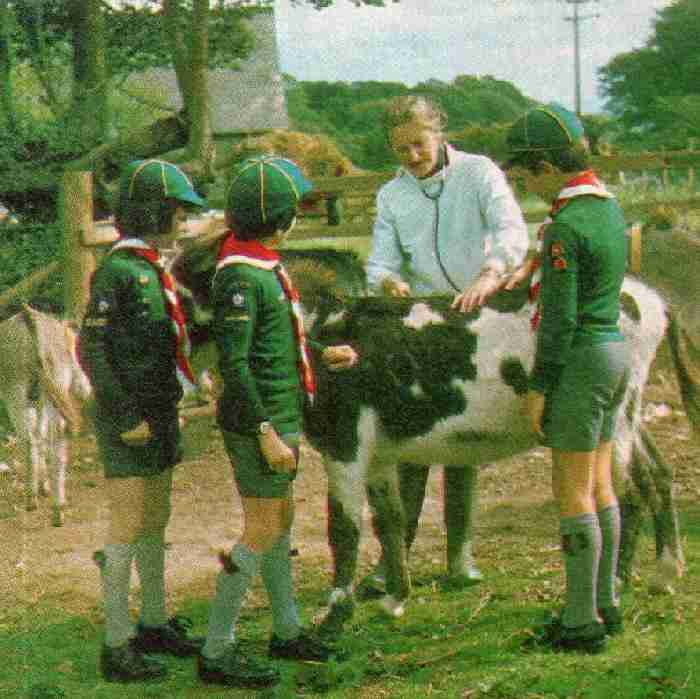
English Wolf Cubs: Outings--Donkey Scantuaries

Figure 1.--We notice this Cub pack at a donkey scantuary. We do not know a great deal about donkey scanturies. These Cubs are visiting in 1979. They are being introduced to a donkey by a caretaker shows one donkey that had been mistreated. The donkey had been forced to do "Donkey Rides" at the seaside before it was old enough.
|
|
We notice a Cub pack at a donkey scantaury. We do not know a great deal about donkey scantuaries. We do know that donkies were popular at English beach resorts. They were used a children's rides and were extremrely popular with the pre-teen children. We are speculating that the refugee was for the donkies that were no longer needed at the beaches. During World War II, beaches became military zones. After the War, the donkies at the beach were never as popular as before. Ther was also increasing concerns with sanitation. We do not know if there was only one or several sanctuaries. The donkies seem well cared for. They were well fed and received vetinarian care. The available images suggest there were only donkies at the sanctuaries. The Cubs were taken on tours to see how the animals were cared for. The boys were allowed to pet and groom the donkies. There were also rides, but nothing to stressful for the donkies like races. Visits to the scantuaries were very popular with the Cubs, especially in the years before wild animal parks. I'm not sure if donkey scantuaries still exist in England.
Donkey Sanctuaries
We notice a Cub pack at a donkey scantaury. We do not know a great deal about donkey scantuaries. They were centers
to retire donkeys and to care for those mistreated. We do not know that there were several such sanctuaries. The donkies seem well cared for. They were well fed and received vetinarian care. A British reader tells us, "The donkey sanctuary shown here if my memory serves me correctly, was not unique. There were a number scattered around the
country but not that many. The purpose was the house donkeys that had either been rescued from previously being mistreated or were simply given up on being retired from their working lives. The image with the 3 boys being introduced to a donkey by a caretaker shows one donkey that had been mistreated. The donkey had been forced to do "Donkey Rides" at the seaside before it was old enough. The weight of the children on its imature backbone had caused permanent debilitating permanent damage." I'm not sure if donkey scantuaries still exist in England. A British reader informs us, "There are several of these in Britain and they are still functioning. There are ads in the press from time to time raising money to keep the places going."
Donkey Rides
We do know that donkies were popular at English beach resorts. Theu might also be hired for festivals and fetes. They were used a children's rides and were extremrely popular with the pre-teen children. Photographic studios at beach resorts even had stuffed donkies on which the children could be photographed. We are speculating that the refugee was for the donkies that were no longer needed at the beaches. During World War II, beaches became military zones. After the War, the donkies at the beach were never as popular as before. Ther was also increasing concerns with sanitation. The available images suggest there were only donkies at the sanctuaries.
Cub Visits
The Cubs were taken on tours to see how the animals were cared for. The boys were allowed to pet and groom the donkies. There were also rides, but nothing to stressful for the donkies like races. Visits to the scantuaries were very popular with the Cubs, especially in the years before wild animal parks. The purpose of the cub scouts visiting was to show them animal welfare in action. I think some of the donkeys were available to be
ridden so that the boys could gain first-hand experience of that and, I suppose, exercise the donkeys at the same time. I doubt if there were races involved, the animals on the whole would have been either too old or too ill and such a competitive concept is probably not in keeping with the English view of animal welfare. A British reader writes, "There would have been no races but the cubs might have been able to ride suitable donkeys."
Best wishes,
Bill
HBU

Navigate the Historic Boys' Uniform Chronology Pages:
[Return to the Main chronologies page]
[The 1900s]
[The 1910s]
[The 1920s]
[The 1930s]
[The 1940s]
[The 1950s]
[The 1960s]
[The 1970s]
[The 1980s]
[The 1990s]
[The 2000s]
Navigate the Historic Boys' Uniform Web Site:
[Activities]
[Biographies]
[Chronologies]
[Countries]
[Essays]
[Garments]
[Organizations]
[Religion]
[Other]
[Introduction]
[Bibliographies]
[Contributions]
[FAQs]
[Questions]
[Unknown images]
[Boys' Uniform Home]
Navigate the Historic Boys' Uniform Web organizatiion pages:
[Return to the Main English Cub outing page]
[Return to the Main English Scout page]
[Return to the National Scout page]
[Boys' Brigade]
[Camp Fire]
[Hitler Youth]
[National]
[Pioneers]
[Royal Rangers]
[Scout]
Created: November 27, 2003
Last updated: December 1, 2003



